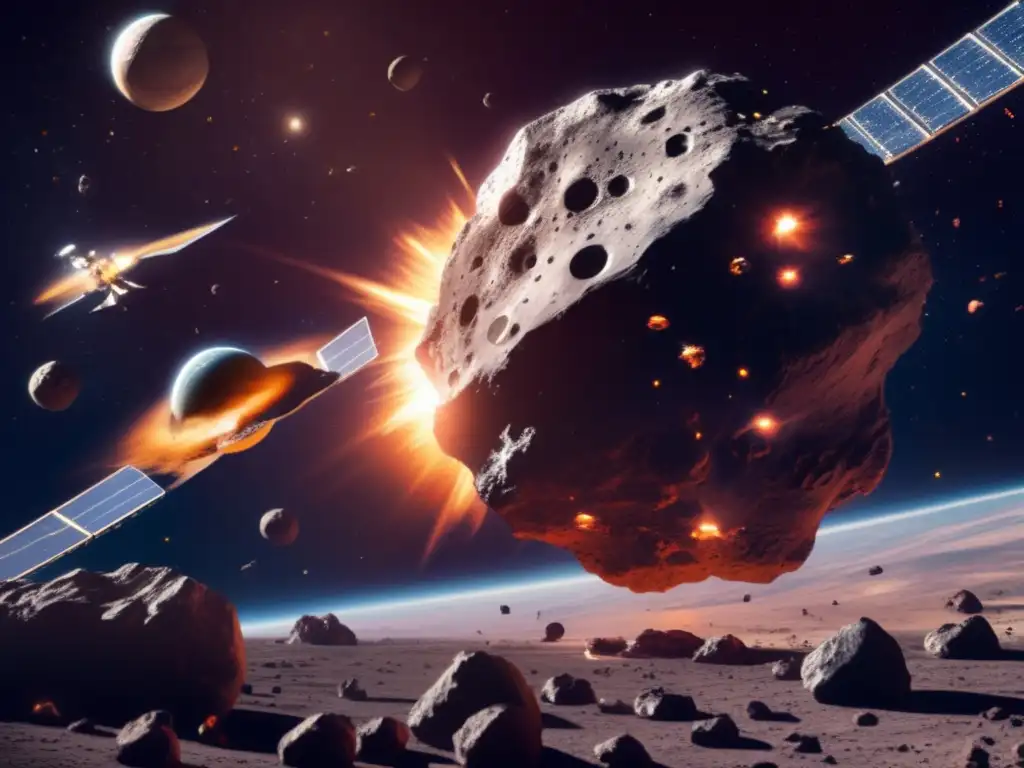Guarding The Cosmos: Strategies Against Asteroid Threats

Introduction
Asteroids are small, rocky objects that orbit the sun. They have been around for billions of years and are often referred to as "leftovers" from the creation of our solar system. Although most asteroids pose no threat to Earth, there are some that could potentially collide with our planet. In this article, we will explore the different strategies that scientists and space agencies use to protect Earth from asteroid impacts.
The Importance of Planetary Defense

NASA's Planetary Defense Coordination Office
NASA's Planetary Defense Coordination Office (PDCO) is responsible for tracking and characterizing near-Earth objects (NEOs), which includes asteroids and comets. The PDCO analyzes the data collected by telescopes all over the world to determine the size, shape, and composition of NEOs. This information helps scientists determine if an asteroid poses a threat to Earth and what type of impact it would have.
The Threat Asteroids Pose to Earth
Asteroid impacts have the potential to cause significant damage to Earth and even lead to mass extinctions. The most well-known example of this is the asteroid impact that is believed to have led to the extinction of the dinosaurs 66 million years ago.
The Need for a Planetary Defense Strategy
The discovery of new asteroids and the potential threat they pose to Earth has led to the need for a planetary defense strategy. The goal of this strategy is to detect and track asteroids, determine their trajectory, and develop plans to deflect or destroy them before they collide with Earth.
Deflection Strategies

Kinetic Impact
One approach for deflecting an asteroid is called kinetic impact. This involves sending a spacecraft to collide with the asteroid at a high speed, altering its trajectory. NASA's Double Asteroid Redirection Test (DART) mission, scheduled to launch in November 2021, will test this method by colliding with the small moon orbiting the asteroid Didymos to see if it can change its orbit.
Gravity Tractor
The gravity tractor method involves using the gravitational pull of a spacecraft to slowly alter the trajectory of an asteroid. The spacecraft would have to hover close to the asteroid for a period of time, allowing its gravitational pull to alter the asteroid's trajectory. This method is still in the theoretical stage, but NASA is considering it as a potential option for future asteroid deflection missions.
Nuclear Explosion
Using nuclear explosives to deflect an asteroid is another strategy that scientists have considered. However, this method is highly controversial due to the environmental and political implications of detonating a nuclear device in space.
Destruction Strategies

Precision Asteroid Deflection System
The Precision Asteroid Deflection System (PADS) is a proposed system that would use a spacecraft to release a cloud of small, high-velocity pellets near an asteroid. The pellets would impact the asteroid at a high velocity, causing it to break apart. While this method has never been tested, it is seen as a potential option for destroying small asteroids.
Directed Energy
The Directed Energy method involves using lasers or other forms of energy to vaporize the surface of an asteroid, causing it to break apart. This method is still in the experimental stage, but scientists believe it could be an effective way of destroying large asteroids.
Kinetic Energy
The kinetic energy method involves using a spacecraft to impact an asteroid at a high velocity, causing it to break apart. This method can only be used on smaller asteroids and is not suitable for larger threats.
Frequently Asked Questions

-
What is NASA's Planetary Defense Coordination Office?
NASA's Planetary Defense Coordination Office is responsible for tracking and characterizing near-Earth objects (NEOs), which includes asteroids and comets. It analyzes the data collected by telescopes all over the world to determine the size, shape, and composition of NEOs.
-
What is the most well-known example of an asteroid impact?
The most well-known example of an asteroid impact is the one that is believed to have led to the extinction of the dinosaurs 66 million years ago.
-
How does the kinetic impact method work?
The kinetic impact method involves sending a spacecraft to collide with the asteroid at a high speed, altering its trajectory.
-
What is the Directed Energy method?
The Directed Energy method involves using lasers or other forms of energy to vaporize the surface of an asteroid, causing it to break apart.
-
Can nuclear explosives be used to deflect asteroids?
Yes, but this method is highly controversial due to the environmental and political implications of detonating a nuclear device in space.
Conclusion
Protecting Earth from asteroid impacts is crucial for the survival of our planet and all life on it. Through the efforts of organizations like NASA's Planetary Defense Coordination Office, we are better equipped to detect and track potentially dangerous asteroids. With the development of new deflection and destruction strategies, we can hopefully prevent future asteroid collisions and preserve our planet for generations to come.
Remember to stay up-to-date with news and developments in asteroid research and defense strategies by following www.asteroidrealm.com!
Additional Resources

For more information about planetary defense and asteroid research, check out these resources:
 Avoiding A Cosmic Cataclysm: Techniques For Asteroid Defense
Avoiding A Cosmic Cataclysm: Techniques For Asteroid Defense Defenders Of Earth: Current Strategies For Asteroid Defense
Defenders Of Earth: Current Strategies For Asteroid Defense Bracing For The Big Bang: Tools For Asteroid Defense
Bracing For The Big Bang: Tools For Asteroid DefenseIf you want to discover more articles similar to Guarding The Cosmos: Strategies Against Asteroid Threats, you can visit the Planetary Defense category.
Leave a Reply

Articulos relacionados: